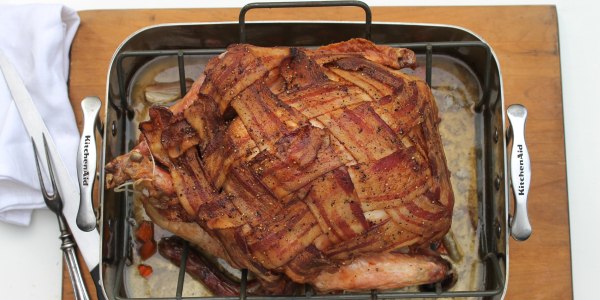
For years, I’d heard that brining held the key to juicy, flavorful turkey. But I don’t own a vat big enough for a Thanksgiving-sized turkey and the gallons of liquid it soaks in, and even if I did, my New York City apartment-sized fridge wouldn’t hold it. Which is why dry-brining, in which you liberally salt the bird several days in advance, has forever changed my holidays. It takes up no more room than the turkey itself, and after you apply the salt rub it just, y’know, sits there. The salt draws out the moisture in the flesh, which then dissolves the crystals. As the bird reabsorbs the now-salty liquid, it flavors the meat all the way to the bone. Because it’s not submerged for days like with wet brine, you wind up with some of the most irresistibly crisp skin imaginable.
Related: How to cook a juicy turkey: Try it with Curtis Stone's Cajun-roasted turkey
The reward-to-effort ratio is off the charts!
This method only works with a turkey that hasn’t been pre-seasoned—so avoid kosher birds, which are salted as part of the koshering process, or self-basting turkeys, which have been injected with a sodium-rich solution. Check the label if you’re not sure, and avoid anything that lists salt as an ingredient.
Get all the recipes you need for the ultimate Thanksgiving!
Dry-brining basics
- The amount of salt you’ll need depends on the brand and the bird. For each pound of turkey, figure 1/2 to 1 teaspoon of kosher salt or 1/2 to 2/3 teaspoon of kosher salt. Don’t use table salt, whose fine grains won’t work well for this purpose.
- Keep it simple with plain salt, or combine with your favorite seasoning. Dried sage, thyme, rosemary, and marjoram add classic Thanksgiving flavors.
- Plan for at least 1 hour per pound in the fridge, and up to three days. I usually do the full three-day extravaganza, placing the seasoned bird in a jumbo zipper-lock bag for the first two days.
- Pat the turkey dry inside and out with paper towels. Carefully loosen the skin on the breast and legs, and rub a generous tablespoon of the salt onto the flesh of each side—go heavier on the breast, where the meat is thickest. Sprinkle remaining salt liberally all over the body and inside cavities. Refrigerate 18 to 36 hours. Give the bird a nice massage once a day to ensure an even distribution of flavor
- For the crispiest skin, 8-12 hours before you plan to roast it, remove the turkey from the bag, pat dry, and return to the fridge, uncovered. (Take care to clear enough space that your other foods don’t touch it.)
- Roast using your favorite method. I prefer a low oven, 325°F, for approximately 15 minutes per pound. Because a dry-brined turkey produces relatively paltry drippings, add 1 or 2 cups of turkey or chicken stock to the roasting pan before it goes into the oven.
Flavor variations
Moroccan: Mix kosher salt with 2 teaspoons ground cumin, 2 teaspoons ground ginger, 2 teaspoons paprika, 1 1/2 teaspoons black pepper, 1 teaspoon cinnamon, 1 teaspoon coriander, 1 teaspoon allspice, 1/2 teaspoon cloves, and 1/2 teaspoon cayenne.
Chili-lime: Mix kosher salt with 3 tablespoons chili powder, 1/2 tablespoon cumin, 1/2 tablespoon dark brown sugar, 3/4 teaspoon garlic powder, 3/4 teaspoon onion powder, 3/4 teaspoon coriander, 1/4 teaspoon cayenne, the zest and juice of 1 lime, and 1 tablespoon olive oil.
Debbie Koenig is the author of the cookbook Parents Need to Eat Too. She lives with her family in Brooklyn.
